Ready to dive into the world of one of the ocean’s most awe-inspiring creatures? The Basking Shark is a creature that combines the mystique of the deep sea with a presence that’s nothing short of mind-blowing. Whether you’re a seasoned marine biologist at heart or just curious about the vast wonders our oceans hold, there’s something undeniably captivating about these gentle giants.
What is the Basking Shark?
The Basking Shark, scientifically known as Cetorhinus maximus, holds the title of the second-largest living shark, right after the whale shark. Unlike their more ferocious cousins, these guys are the chilled-out vegetarians of the shark world. Well, sort of. They’re filter feeders, which means they swim around with their ginormous mouths wide open, scooping up plankton and small fishies along the way. Picture cruising down the highway with the sunroof open, catching all the breeze – that’s their vibe, but underwater.
Basking Sharks have a bit of a nomadic lifestyle, traveling vast distances across temperate seas. They’re not the type to stay put in one area, making them the adventurers of the deep blue. Despite their imposing size, they’re known for being incredibly docile, making them a favorite among marine enthusiasts and researchers alike.
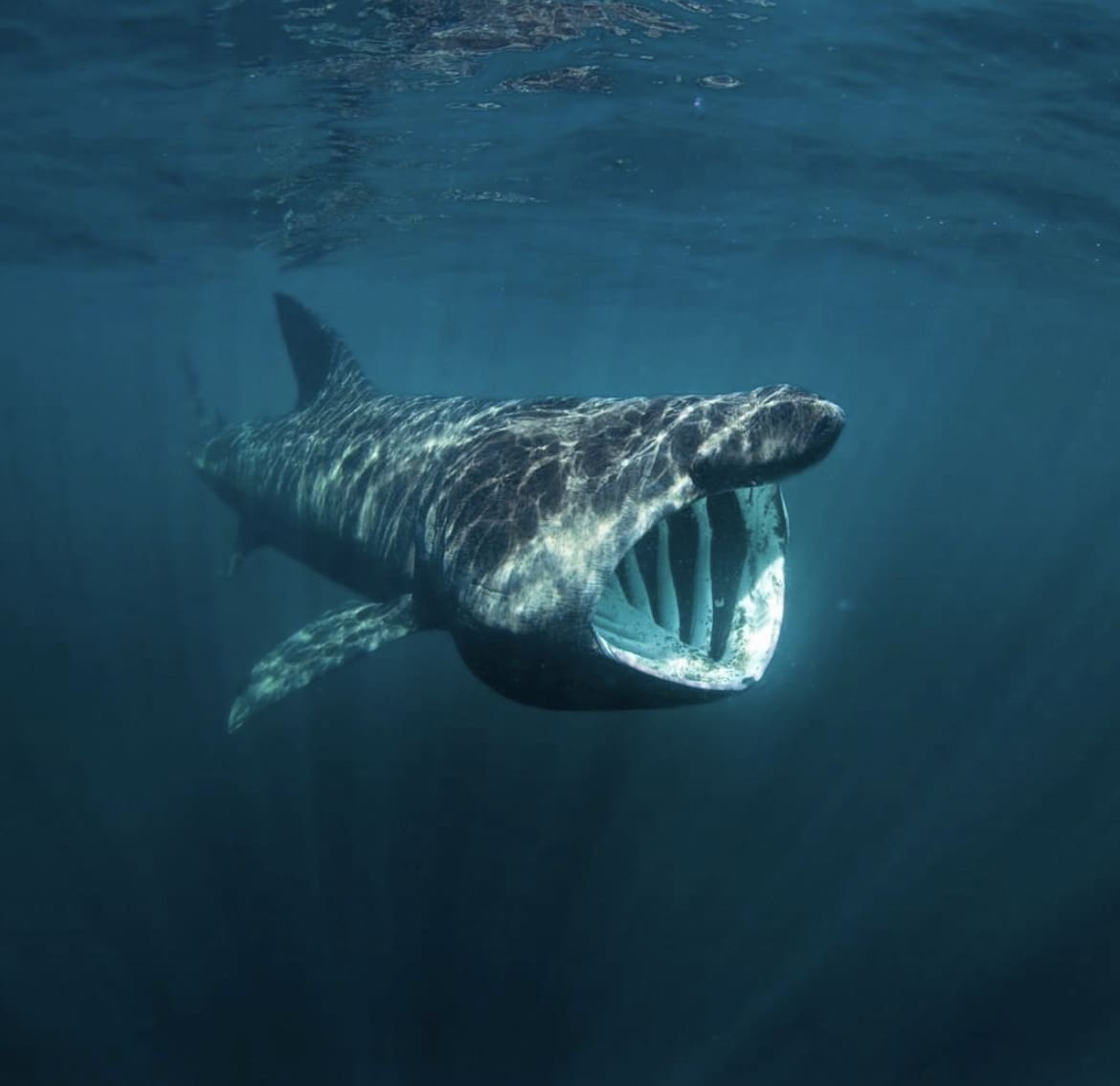
What do Basking Sharks look like?
Imagine a creature that can grow up to 10 meters (that’s about 33 feet for us non-metric folks) long, with a silhouette that’s unmistakable against the backdrop of the open sea. Basking Sharks have elongated, torpedo-shaped bodies, perfect for leisurely gliding through the water. Their most striking feature has to be their massive, wide-open mouths. We’re talking about a gaping maw that looks like it could swallow you whole.
Their skin is a rough-textured marvel, covered in tiny scales called dermal denticles, giving it a sandpaper-like feel. And those fins? Majestic doesn’t even begin to cover it. Their dorsal fins can stand tall like the sail of a ship, making them quite the sight when they break the water’s surface. As for coloration, they’re usually a dusky grey or brown, with a mottled pattern that works wonders for camouflage in the sun-dappled waters they call home.
How big are Basking Sharks?
Adult Basking Sharks can range from 6 to 10 meters long, with the occasional giant reaching lengths of up to 12 meters. That’s longer than a school bus! Their weight is equally impressive, tipping the scales at around 4 to 7 tonnes. Despite their massive size, they’re incredibly graceful swimmers, moving through the water with a slow, steady pace that’s almost hypnotic to watch.
Their size plays a crucial role in their feeding habits. Being so large allows them to filter vast quantities of water for plankton, their primary food source. It’s a bit like using a net to catch butterflies – if the net were the size of a living room and the butterflies were floating in the ocean.
Basking Shark Skin
If you’re imagining something smooth and sleek, think again. Basking Shark skin is rough, covered in tiny, tooth-like structures called dermal denticles. This isn’t your average shark skin – it’s so abrasive, it was once used as sandpaper!
Besides giving DIY projects a run for their money, this rugged exterior reduces drag, allowing these colossal creatures to glide effortlessly through the water. Their skin is a testament to nature’s ingenuity, providing a perfect blend of durability and efficiency.

Basking Shark Teeth
Now, onto the teeth, which might not be what you expect. If you’re picturing the menacing jaws of a Great White, prepare for a plot twist. Basking Shark teeth are tiny, almost inconsequential when you consider their diet doesn’t require much chewing.
These little nubs are more of a historical footnote, a reminder of their evolutionary past. They filter feed, swimming with their mouths open wide to catch plankton, so their teeth are like the appendix of the shark world – still there, but not really in use.
Basking Shark Fins
Picture this: a fin slicing through the water’s surface, ominous and foreboding. Now, replace that fear with awe because Basking Shark fins are nothing short of spectacular. Their dorsal fins can stand tall, a dramatic sight that signals the presence of these gentle giants beneath the waves.
Pectoral fins stretch out wide, stabilizing their massive bodies as they navigate the ocean’s vast expanse. These fins aren’t just for show; they’re pivotal for steering and maintaining balance. In the case of the Basking Shark, bigger really does mean better.
Basking Shark Colouration
Basking Sharks don a subtle palette of greys and browns, with a mottled pattern that could give any camouflage gear a run for its money. This isn’t just about looking good; it’s about blending in.
The dappled sunlight filtering through the water disguises them from any threats that might lurk below, making them masters of disguise in their pelagic playground. Their understated elegance is a reminder that in the ocean, sometimes the best way to stand out is to blend in.
What do Basking Sharks eat?
Alright, picture this: a giant shark, cruising through the ocean, mouth agape, collecting… plankton? Yip, Basking Sharks are like the gentle giants of the sea, feasting on the ocean’s tiniest buffet. Their menu mainly consists of plankton, tiny fish, and invertebrates. They’re the oceanic equivalent of a food truck specializing in micro-delicacies.
By swimming with their enormous mouths open, they filter these snacks through their gill rakers—a fancy term for the built-in sieve that traps the food while letting water flow out. It’s a bit like using a strainer to keep the good stuff while ditching the rest, only on a massive, swimming scale.
Basking Shark Feeding in the waters off Scotland | @bertiegregory
Basking Shark social structure
When it comes to socializing, Basking Sharks are the mysterious loners of the shark world, usually spotted solo or in small, temporary groups. However, during peak plankton season, they’re known to form larger aggregations, like underwater conventions for plankton enthusiasts.
These gatherings aren’t about socializing in the human sense; they’re more about being in the right place at the right time for the best feeding opportunities. Outside of these feeding frenzies, Basking Sharks prefer the solo life, roaming the oceans in serene solitude.
How do Basking Sharks reproduce?
The love life of a Basking Shark is something of a mystery. What we do know is that they are ovoviviparous, meaning their eggs hatch inside the female’s body, and she gives birth to live young—a common trait among sharks.
However, Basking Shark babies (pups) are rarely seen, and much of their reproductive behavior remains unknown. It’s believed they give birth to relatively well-developed pups, though details on gestation periods and mating rituals are still the stuff of marine biology mysteries.
In a world where so much is known, Basking Sharks remind us that nature still has its secrets.
How long do Basking Sharks live?
Basking Sharks are the marathon runners of the shark world, boasting lifespans that can stretch over decades. Scientists estimate these creatures can live up to 50 years or more.
However, pinpointing their exact lifespan is challenging due to their elusive nature and the depths at which they roam. Like fine wine, they seem to get better with age, growing larger and, presumably, wiser to the ways of the ocean. This longevity is a testament to their resilience and the mysteries that the ocean still holds about its inhabitants.
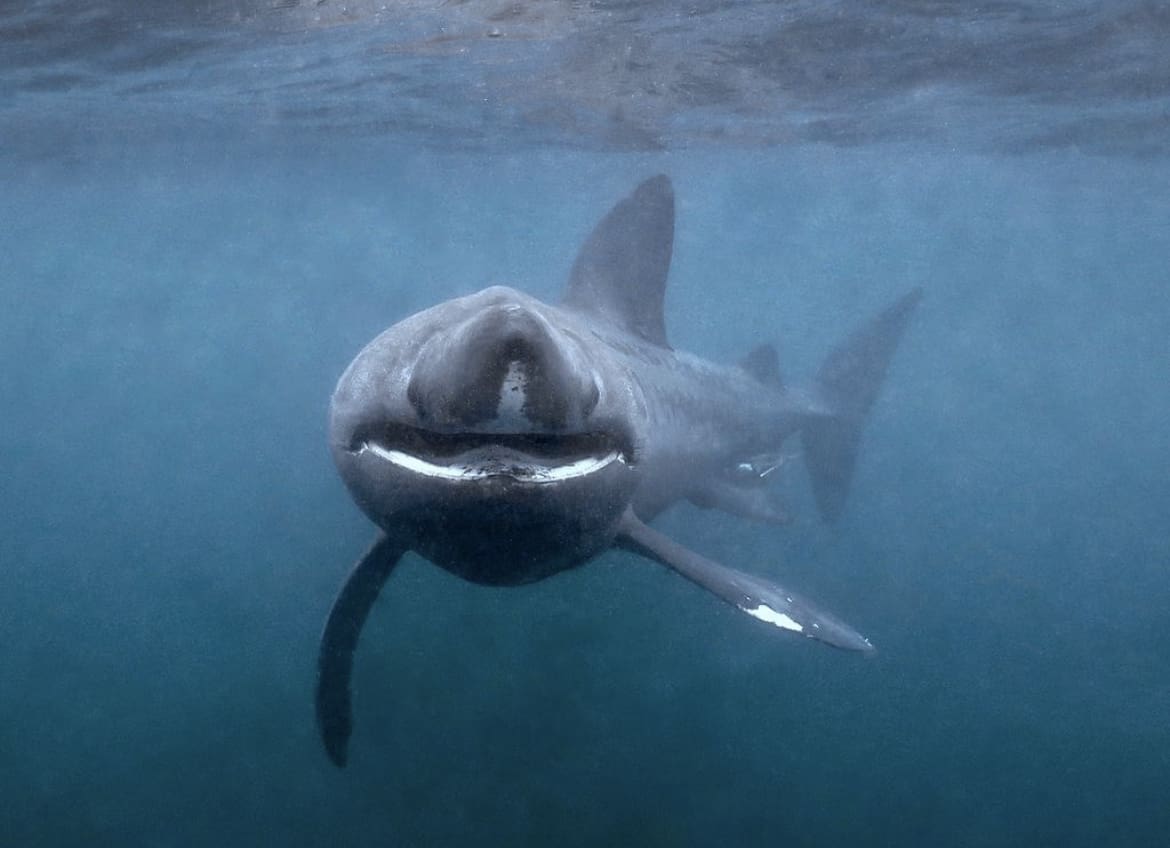
Is the Basking Shark dangerous?
Despite their formidable size and somewhat ominous name, Basking Sharks are about as dangerous to humans as a giant floating log. There have been no recorded incidents of a Basking Shark harming a human.
Their diet strictly consists of plankton, which they filter out of the water, making them the gentle giants of the sea. So, if you ever find yourself swimming alongside one, worry more about the selfie angle than a potential attack. Their passive nature and disinterest in anything larger than microorganisms make them a marvel rather than a menace.
Do Basking Sharks eat people?
To put it bluntly, no, Basking Sharks do not eat people. Their teeth are minuscule and not designed for munching on anything as substantial as a human. They’re strict planktivores, meaning their diet revolves around the microscopic buffet the ocean currents serve up.
The idea of a Basking Shark turning to humans for a snack is as likely as finding a vegetarian wolf – it’s simply not in their nature. So, if you’re planning an ocean adventure and encounter one of these giants, the only thing you’ll need to feed them is your fascination.
READ NEXT: GET TO KNOW THE BULL SHARK
Are Basking Sharks territorial?
Unlike some of their shark cousins, Basking Sharks don’t have a territorial bone in their body – figuratively speaking, of course. They’re known to roam the vast oceans, following plankton blooms rather than staking claim to any particular area.
Their migratory patterns are driven by food availability and water temperatures, not by a desire to dominate a specific territory. This nomadic lifestyle underscores their adaptation to a life in constant motion, ever in pursuit of the ocean’s microscopic bounty rather than guarding a patch of sea.
@baskingsharkscotland
How fast are Basking Sharks?
When it comes to speed, Basking Sharks won’t be winning any underwater races. They’re the cruisers of the marine world, typically swimming at a leisurely pace of about 2 to 3 miles per hour.
However, don’t let their relaxed speed fool you; these sharks are built for endurance, not sprints. Their slow, steady movement is perfectly suited for their filter-feeding lifestyle, allowing them to efficiently process water for plankton as they glide through the sea.
So, while they may not break any speed records, Basking Sharks have mastered the art of the gentle journey, proving that sometimes, slow and steady does indeed win the race.
Where do Basking Sharks live?
Basking Sharks are cosmopolitan travelers, found in temperate waters all around the world. From the cool currents of the North Atlantic to the warmer waters off the coast of California and the Mediterranean Sea, these sharks have a wide range of postal codes.
They prefer the shelf seas, where plankton is plentiful, but are known to dive deep into the ocean, reaching depths of over 900 meters (nearly 3,000 feet) when traveling or searching for food.
Their habitat preference underscores their nomadic nature, always on the move, following the ebb and flow of plankton blooms that dictate their migrations.
How many Basking Sharks are there in the wild?
Quantifying the exact number of Basking Sharks in the wild is a challenging task, given their elusive nature and expansive roaming habits. However, it’s known that their numbers have declined significantly due to past hunting for their liver oil, skin, and fins.
While exact population figures are hard to come by, the consensus among conservationists is that Basking Sharks are increasingly rare.
Efforts to monitor and protect these sharks are ongoing, with marine protected areas and regulations on shark finning playing a crucial role in their conservation.
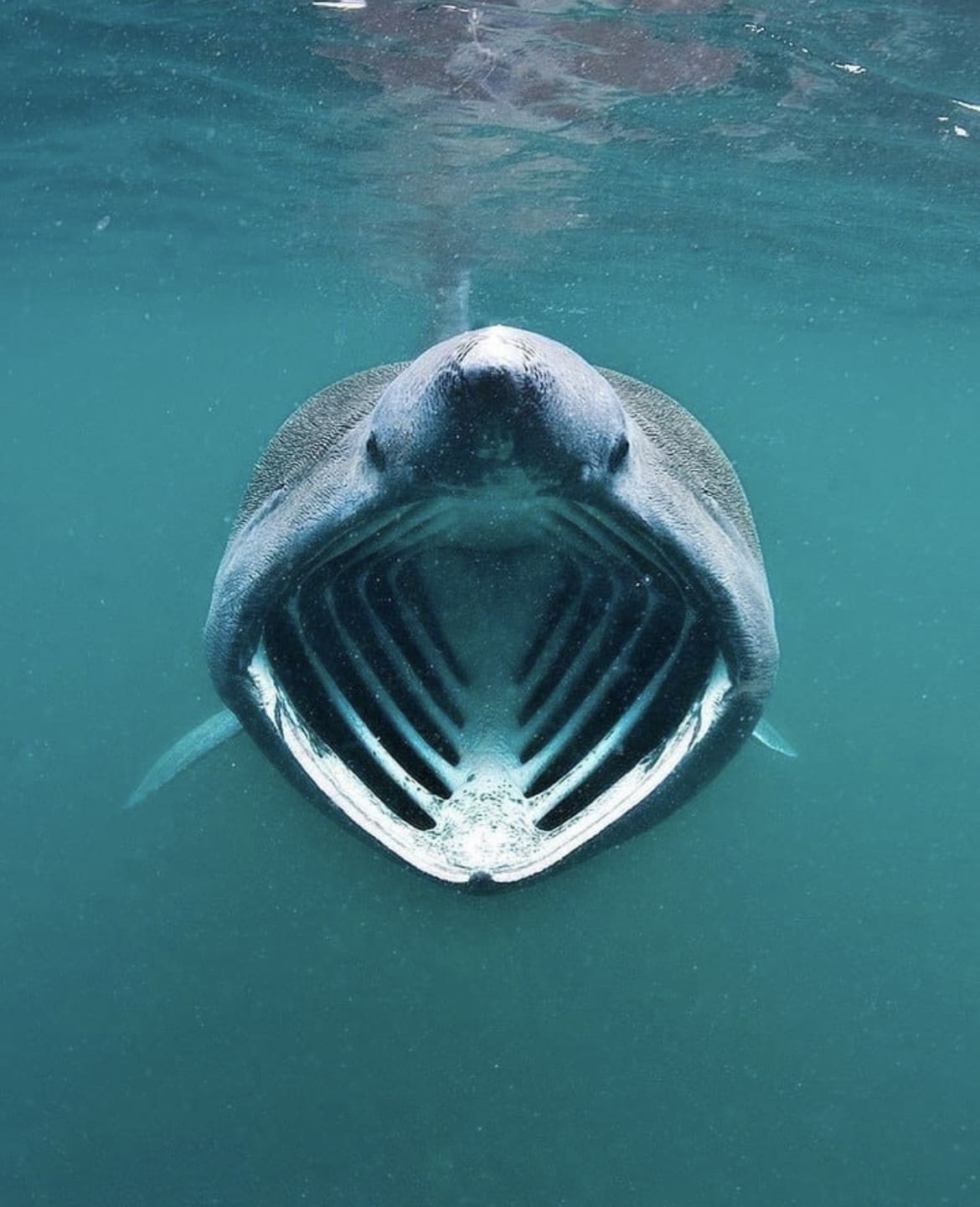
Are Basking Sharks endangered?
The narrative surrounding the Basking Shark’s conservation status is a poignant reminder of the impact human activities have on marine life. Classified as vulnerable by the IUCN, Basking Sharks have faced centuries of exploitation.
Their slow reproduction rate, coupled with a history of targeted fishing for their liver oil, meat, and fins, has led to a significant decline in their populations globally.
The good news? There’s a growing awareness and effort to protect these magnificent creatures, with various international protections and conservation measures in place aimed at reversing the trend of their decline.
Threats to Basking Sharks in the wild
The threats facing Basking Sharks are as vast as the oceans they inhabit. Aside from historical overfishing, they’re still at risk from bycatch, marine pollution, and habitat loss.
Climate change also poses a significant threat, altering the distribution of plankton, which directly impacts the feeding grounds essential for their survival. The increasing traffic in the world’s oceans further complicates their peaceful existence, with ship strikes becoming a concerning reality. It’s a challenging scenario, one that requires concerted global efforts to mitigate and ensure the Basking Shark’s future.
Where to see Basking Sharks
For those yearning to witness the serene beauty of Basking Sharks, there are specific spots around the globe where your chances are higher. The waters off the coast of Cornwall, England, the Isle of Man, and parts of Scotland are renowned for seasonal Basking Shark sightings.
Further afield, the shores of Nova Scotia, Canada, and certain areas along the California coast in the United States also offer opportunities to spot these sharks. Timing is crucial, with late spring and early summer being peak seasons as the sharks follow plankton blooms closer to the surface.
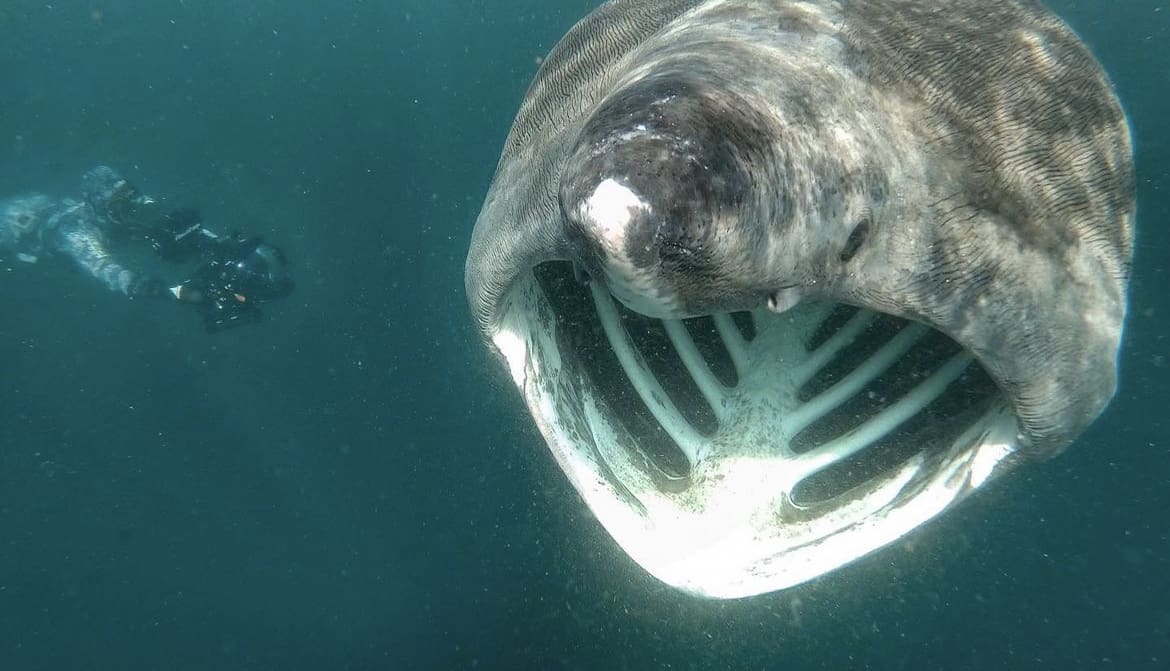
Tips for spotting Basking Sharks
Spotting a Basking Shark requires a blend of patience, timing, and a bit of luck. Here are a few tips to increase your chances:
- Timing is Everything: Plan your adventure during peak seasons (late spring to early summer) when Basking Sharks are more likely to be near the surface.
- Stay Informed: Connect with local wildlife tours and conservation groups for the latest sighting information and responsible viewing guidelines.
- Respect Their Space: Always maintain a respectful distance. These are wild animals, and our presence should not disrupt their natural behaviors.
- Be Patient: Nature operates on its own schedule. Enjoy the wait and keep your eyes peeled for that unforgettable fin breaking the surface.
Facts about the Basking Shark
- Second Largest Fish: Basking Sharks hold the title of the second-largest living fish, with only the Whale Shark out-sizing them.
- Gentle Giants: Despite their massive size, Basking Sharks are harmless to humans, feeding exclusively on plankton which they filter out of the water.
- Global Nomads: These sharks have a vast range, found in temperate waters all around the globe, from the surface down to depths of nearly 3,000 feet.
- Slow and Steady: Basking Sharks are not in a hurry, moving at a leisurely pace of about 2-3 miles per hour as they filter-feed.
- Big Mouths: They can open their mouths up to about 3 feet wide to filter water for plankton, their primary source of food.
- Economical Swimmers: Despite their bulk, Basking Sharks are efficient in the water, using their large dorsal and pectoral fins to glide with minimal effort.
- Long-Lived: Estimated to live up to 50 years or more, Basking Sharks have a relatively long lifespan for marine creatures.
- Rare Sightings: Baby Basking Sharks are seldom seen, and much of their early life remains a mystery to scientists.
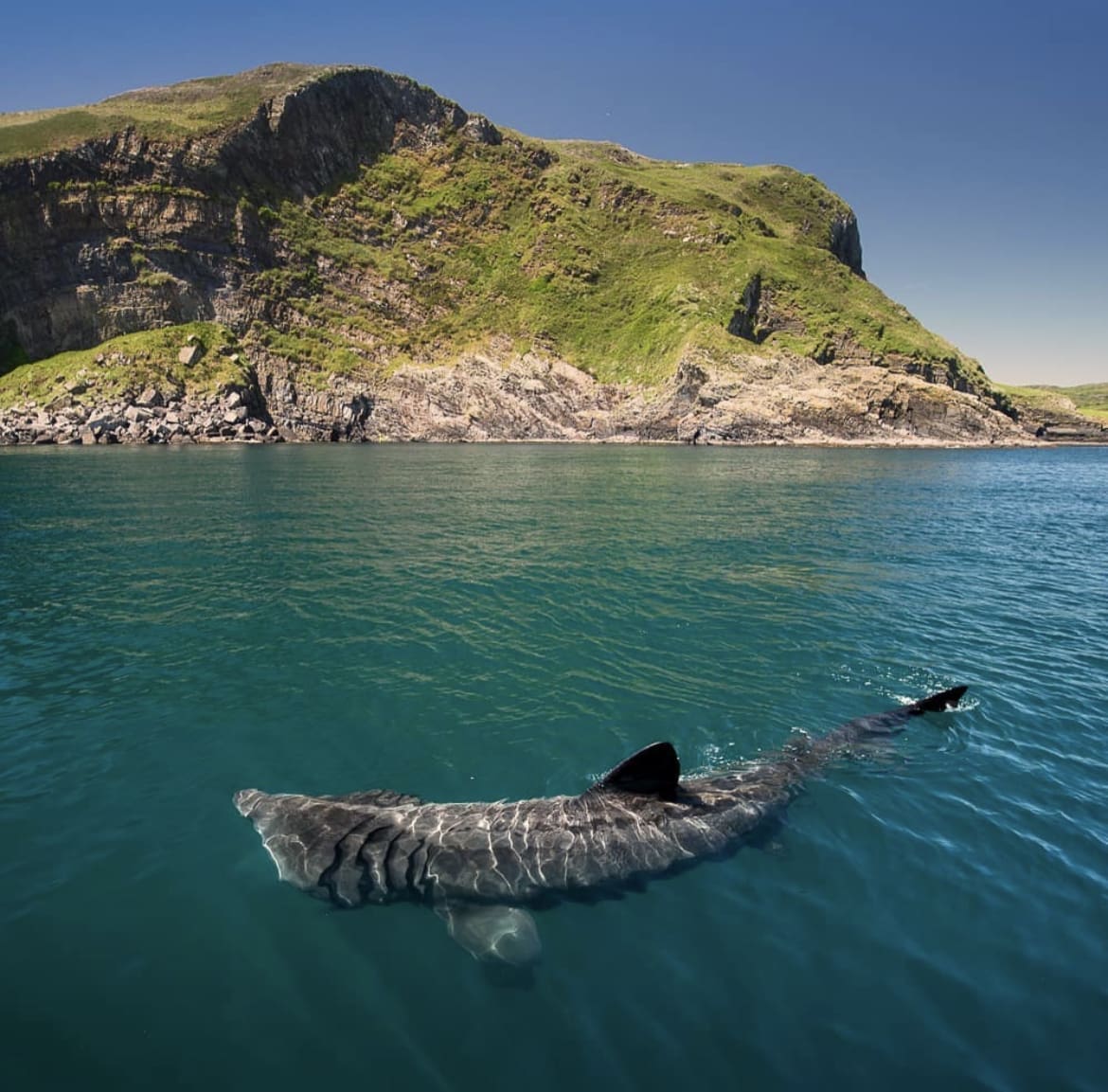
Myths about the Basking Shark
- Man-Eaters: Contrary to the fearsome image of sharks, Basking Sharks pose no threat to humans. Their diet consists entirely of plankton, and their teeth are not suited for eating larger prey.
- Aggressive Predators: Despite their size, Basking Sharks are some of the most docile creatures in the ocean. They have no interest in attacking or threatening humans or other large marine animals.
- Stationary Life: Some believe Basking Sharks spend most of their time basking at the surface. While they can often be seen near the surface, they are actually highly migratory, traveling great distances in search of food.
- Easy to Find: Due to their large size, there’s a myth that Basking Sharks are easy to spot. In reality, their elusive nature and the vastness of their habitat make them a rare sight, even in areas where they are known to frequent.
- Unchanging Population: There’s a misconception that, due to their size, Basking Sharks are not at risk. However, they are classified as vulnerable, facing threats from human activities and environmental changes.
